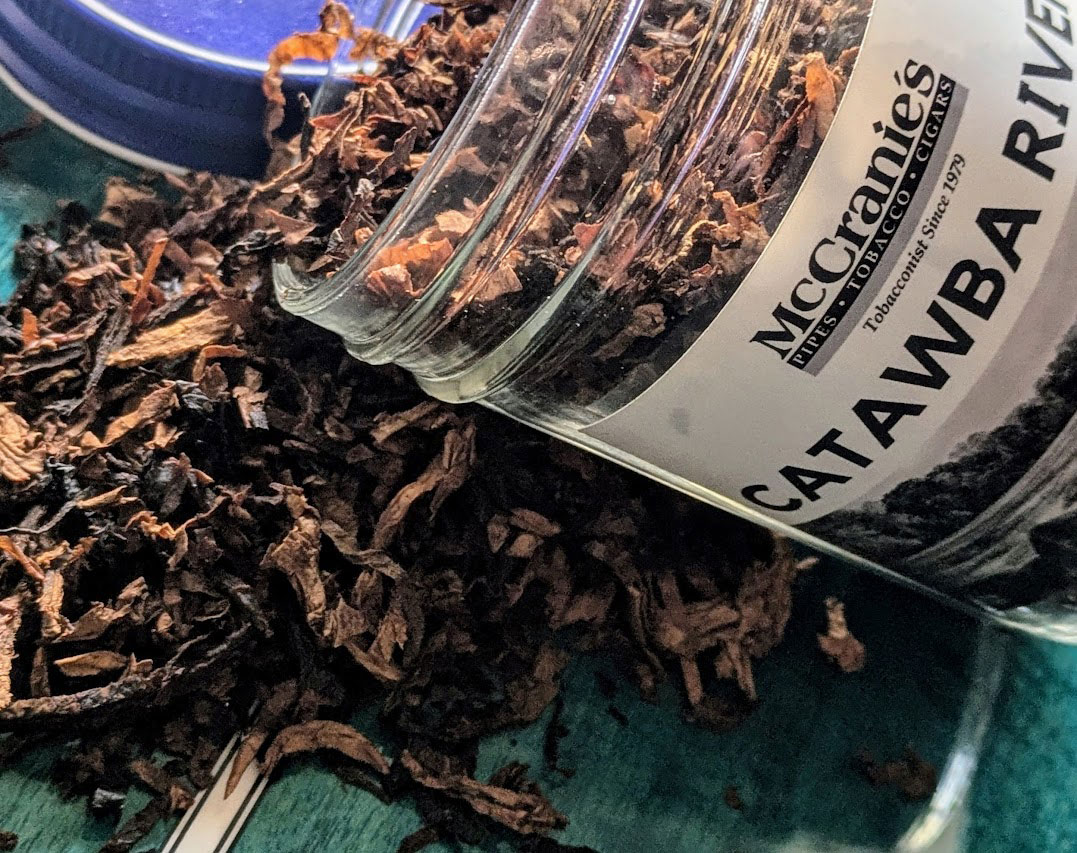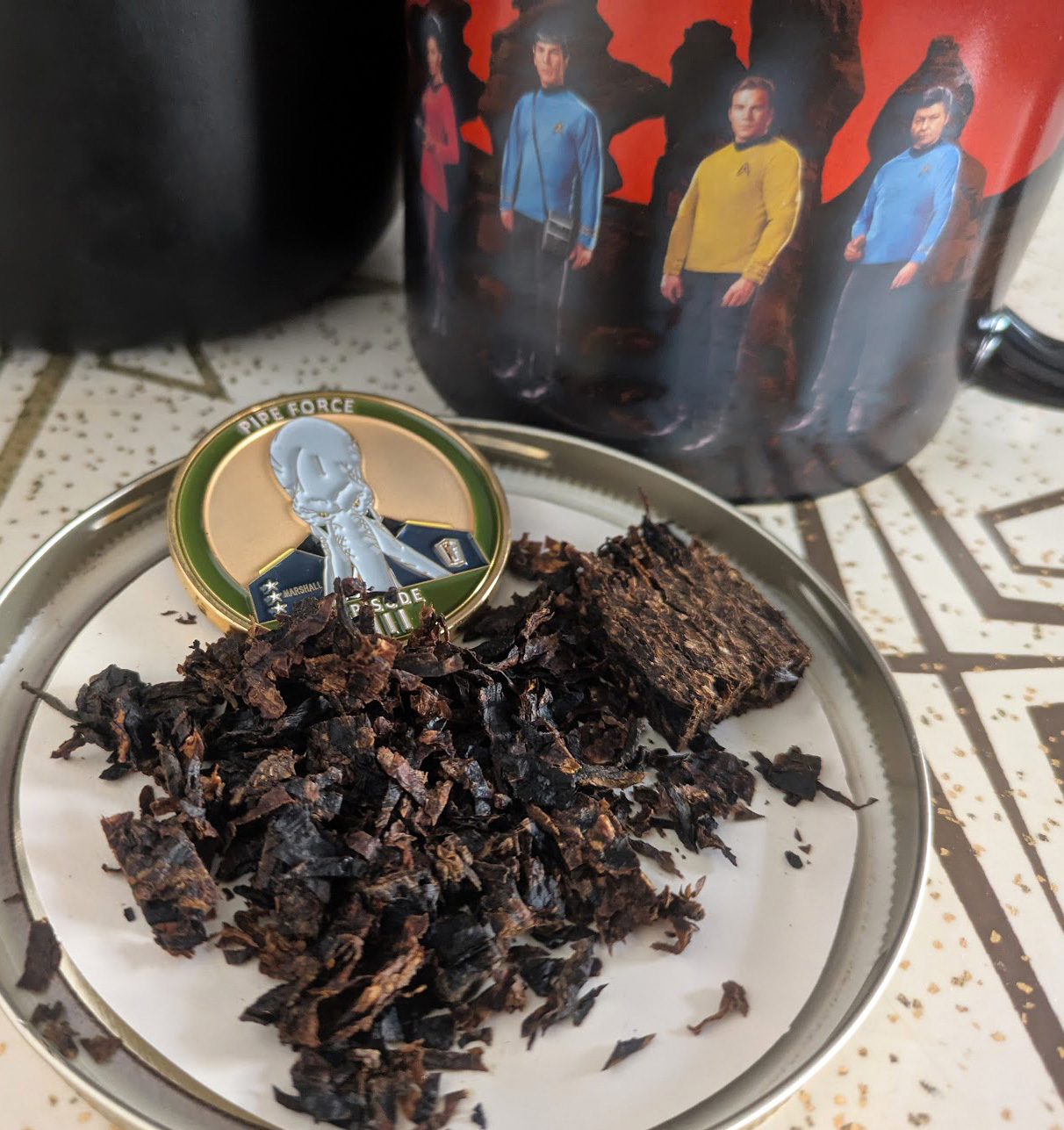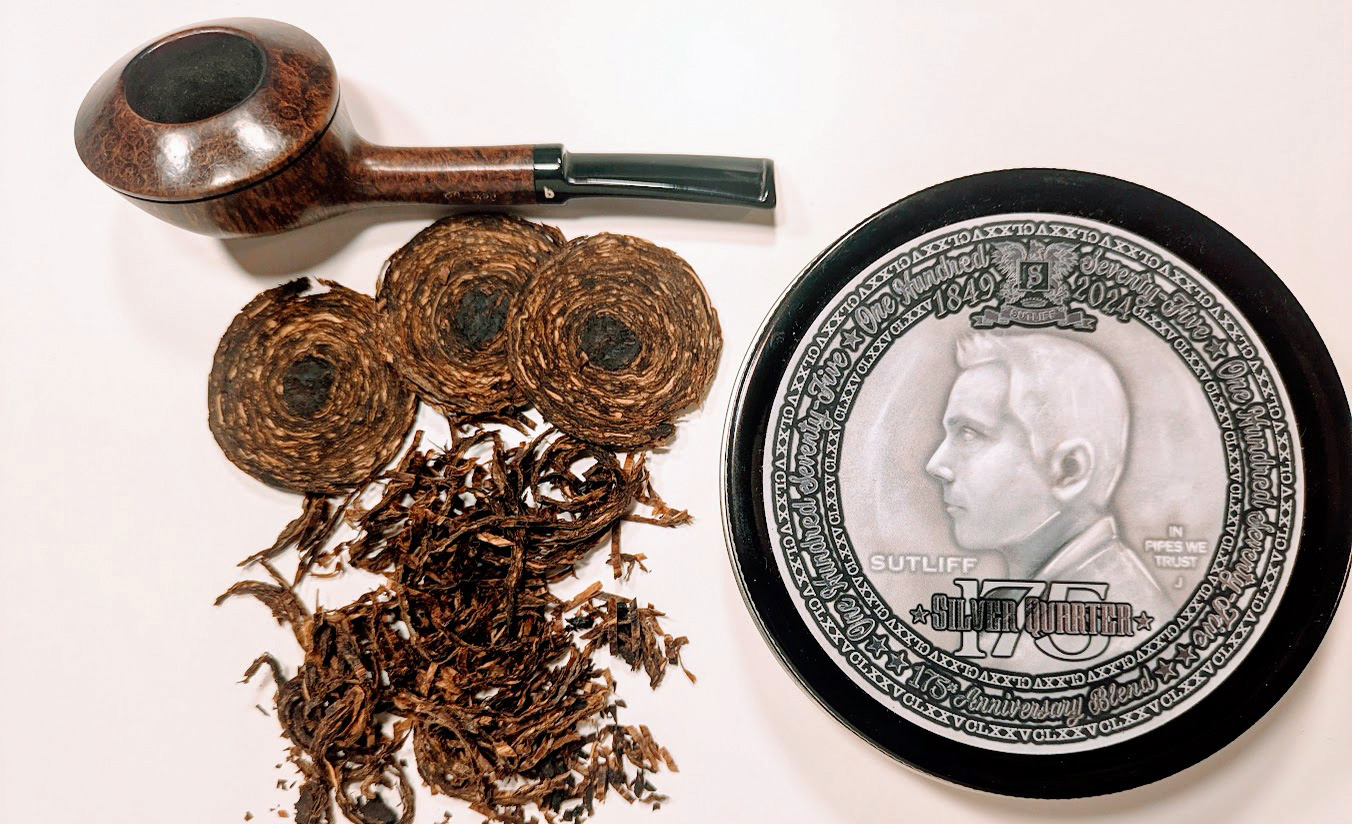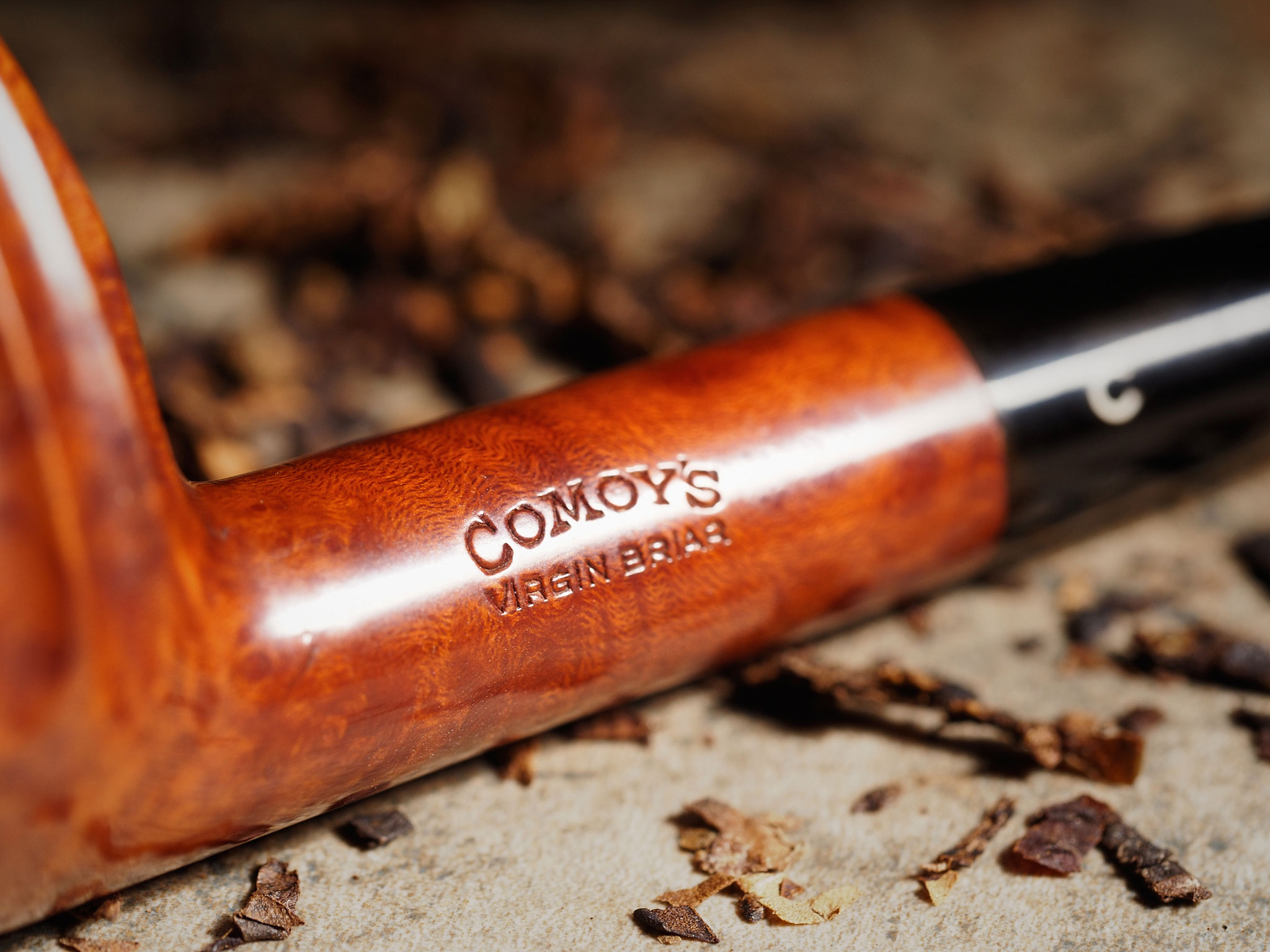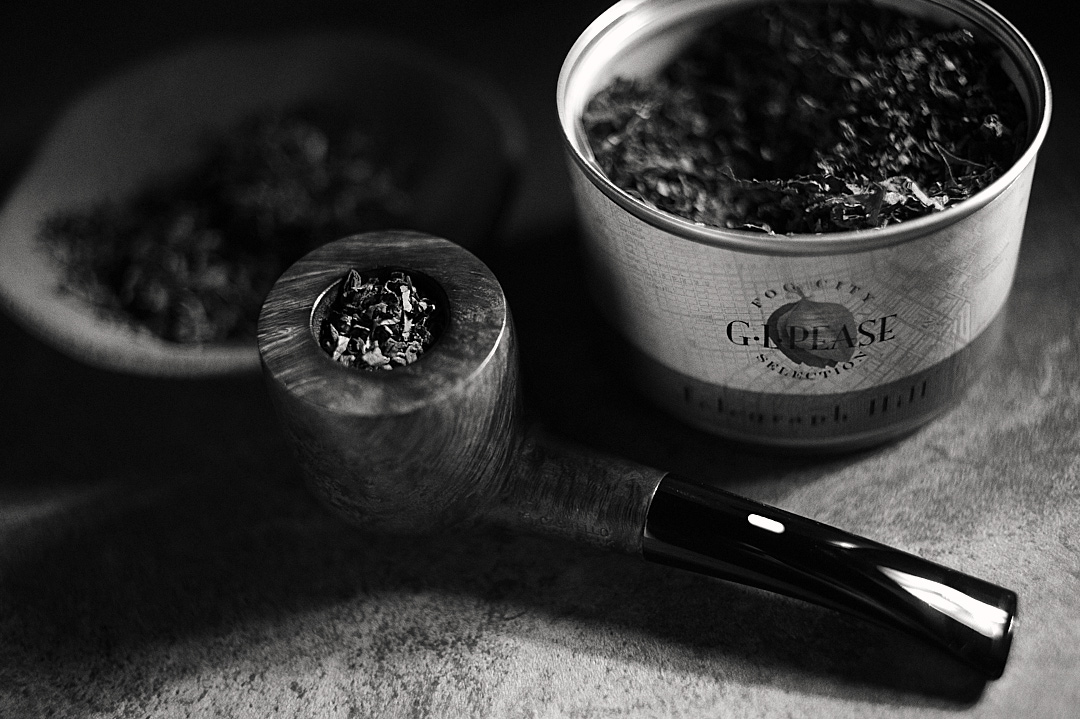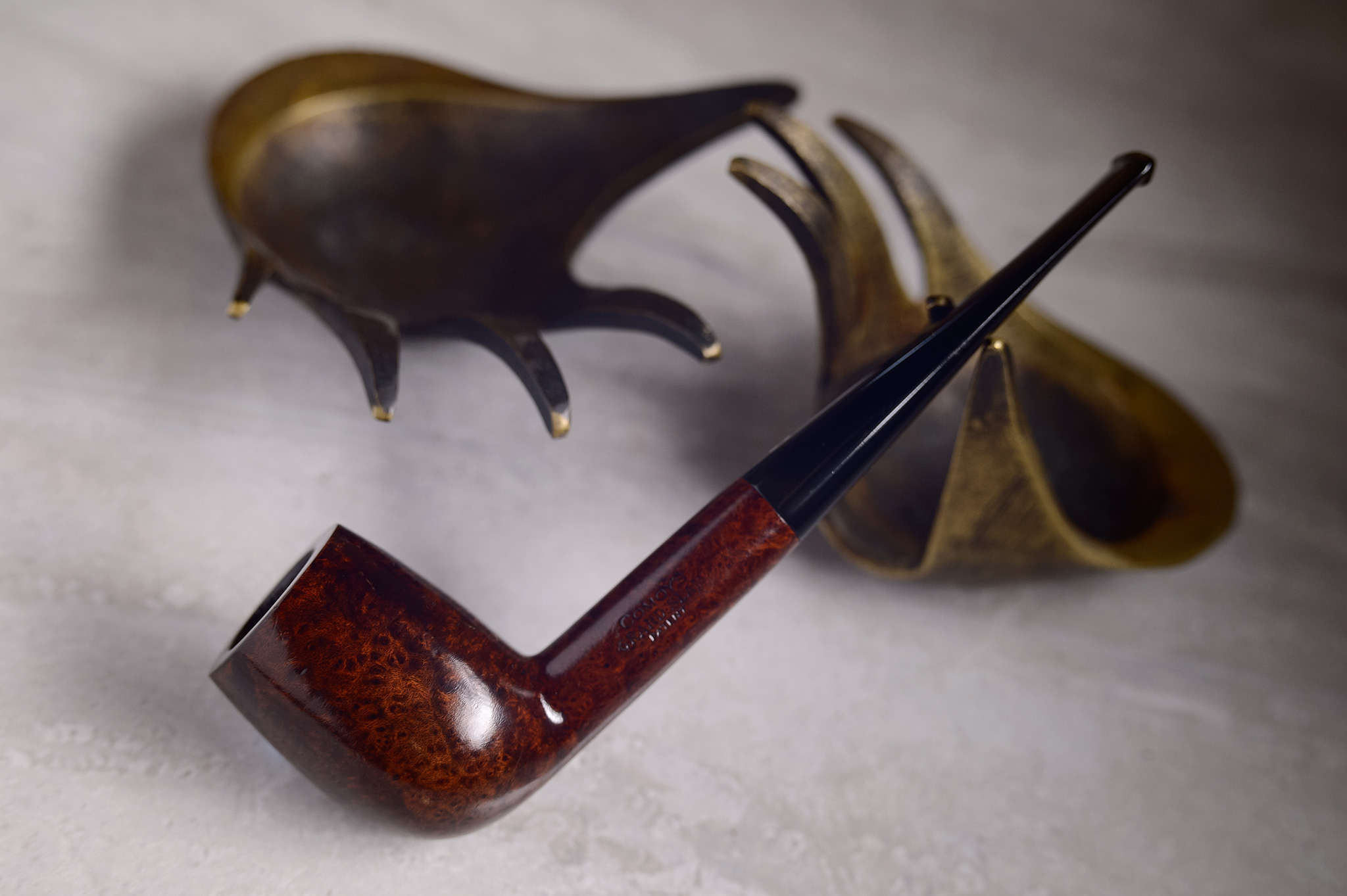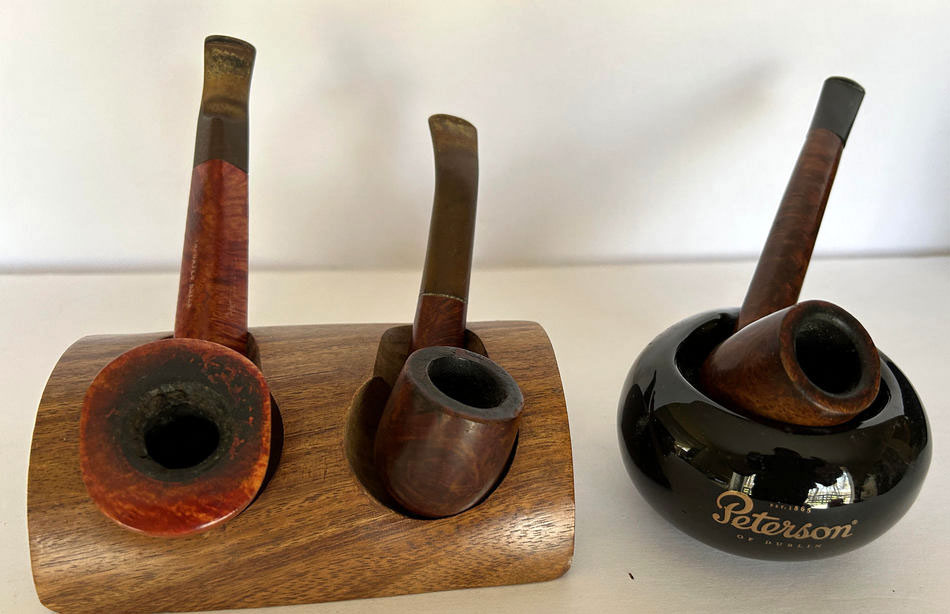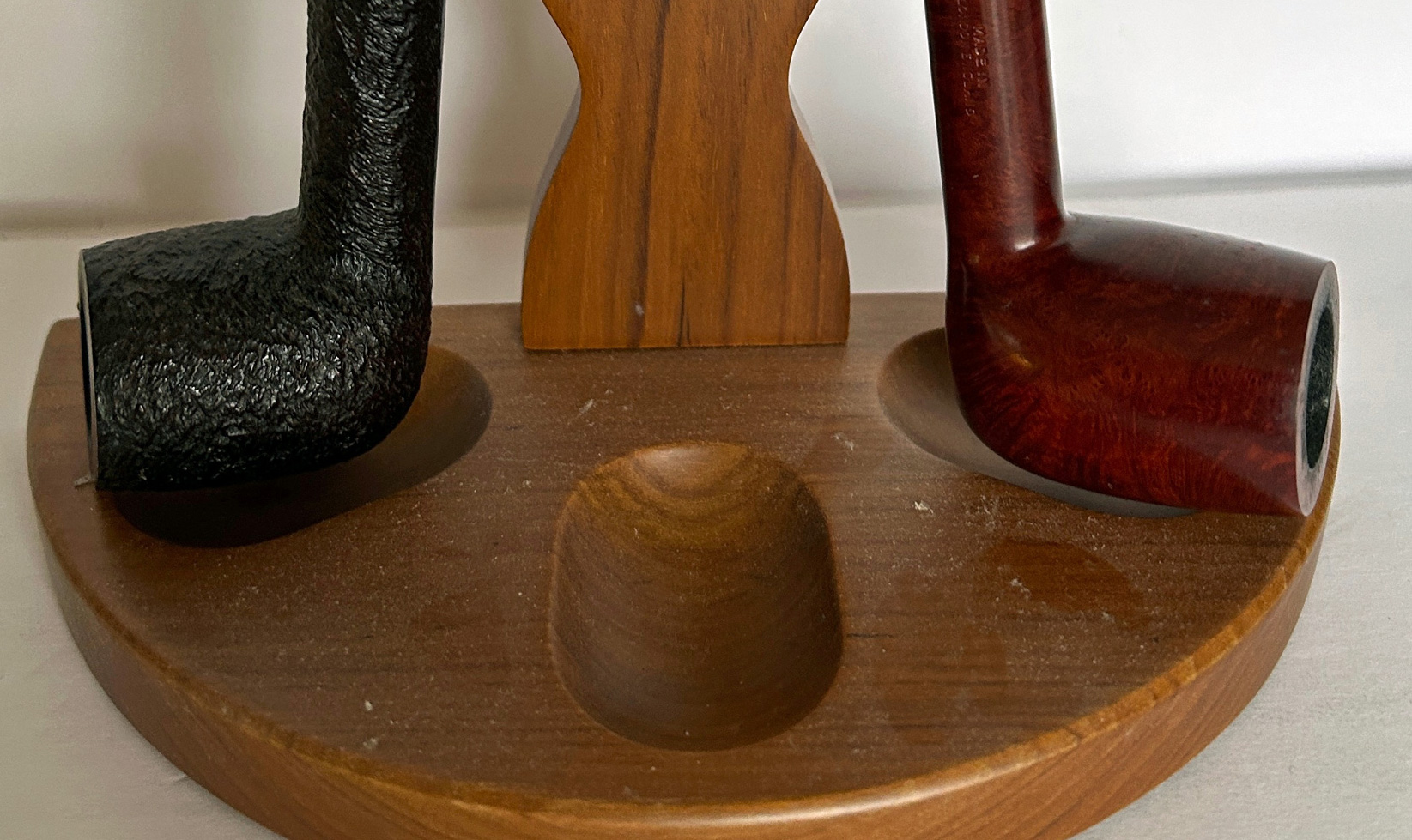Radio Talk Show
- Pipes Magazine Radio Show Episode 658
Welcome to The Pipes Magazine Radio Show Episode 658. Our featured interview on tonight’s show is with Bo Parker. Bo is the new co-host of the Pipe and Tamper Podcast, which is the second longest running pipe podcast after this one. Bo started as the co-host in January 2025, and he is also a member of the Heretics Pipe Club. He is a professional coffee roaster and has the best “first time I smoked a pipe story” ever. At the top of the show, we will have another edition of the virtual tour of Brian’s pipe collection with four more Smio Satou pipes.
- Pipes Magazine Radio Show Episode 657
Welcome to The Pipes Magazine Radio Show Episode 657. Our featured interview on tonight’s show is with Ben Smith of Redeemed Pipes. Ben is a pipe restorer, buyer and seller. He helps collectors find the estate pipes they are looking for. He started Redeemed Pipes in 2022 at his first Chicago pipe show. He deals with all types of pipes from artisan to factory-made. He actually started smoking pipes in 2017, and soon became obsessed, and quickly progressed to collecting artisan pipes himself. At the top of the show Brian will discuss “Estate Pipe Buying 101”.
- Pipes Magazine Radio Show Episode 656
Welcome to The Pipes Magazine Radio Show Episode 656. Our featured interview on tonight’s show is with Nate King, the “King of Pipes” and of In-N-Out Burger. Most people know of Nate as an excellent pipe artisan. He also has an honorary Master of Pipes degree from the Chicagoland Pipe Collectors Club, and is a member of the prestigious Confrérie des Maitres Pipiers de Saint-Claude. Prior to becoming a pipe maker in 2005, Nate worked in the Indy race business as a transmission specialist. At the top of the show Brian will have a tobacco review of Low Country Atalaya. It is a Virginia/Perique blend made in the Cornell & Diehl factory.
Tobacco Reviews
- McCranie’s Catawba River Tobacco Review
There has been a lot written about the Lakeland style of tobaccos over the past couple of centuries. Perhaps nothing else in the tobacco world is quite as polarizing, tending to segregate folks into camps of loving it or despising it with uncharacteristic vehemence. This month’s inspection of an American rendition of the Lakeland style will add just a few more words to the volumes that have come before, but in the interest of topicality I’ll avoid the larger debates, histories, and comparisons, limiting our purview to the experience of this blend alone. Though it’s the earliest hint of an impending spring now, I began sampling this tobacco in the fall. At first, it was mild and pleasant, lightly aromatic, and earthy in a very appealing way. However, when winter’s foul weather hit, I moved on to other tastes. Through no particular fault of the tobacco, it just didn’t fit for my tastes at the time—as is often the case, and, I’m sure, an experience shared with the vast majority of pipe smokers out there. But now the world is thawing, and the faintest scent of the re-emergence of all things growing is in the air. Unscrewing the jar of Catawba River once again, I am treated to a soft and slightly sweet aroma perfectly concomitant with the weather and my mood. “McCranie’s Catawba River is a lakeland style aromatic tobacco. Notes of honey and berries give the blend an outstanding aroma. Comprised of cavendish, burley, and a dash of perique. A singular mixture sure to entice every aromatic smoker.” The first thing to note is an appreciation for the McCranie’s Choice Reserve blends being offered in full 2-ounce glass jars, as it’s the surest way to keep them properly intact when shelved for longish periods—I naturally have a predilection to hopscotch around between a dozen or so open blends at any given time before finishing the tins, and this saves me the trouble (which I admittedly rarely do anymore) of transferring them to a truly airtight container for safe keeping. It also affords a gander at the leaf before opening; in Catawba River’s case a nicely balanced mottle of dark and mahogany brown interspersed with the occasional raw umber-toned leaf. The first thing to note when opening the tin is the rush of rich aromas: milk chocolate and cherry predominate, with a defined floral tilt; sweet fringes of honey and melon; even hints of a complex background note of root beer or sarsaparilla, likely the telltale sign of Perique in the mix. It’s not a cloying sweetness, and is rather transparently layered atop the earthy and acrid tobacco smell. It is a fine balance, and the leaf is as soft and supple as the aroma. If one is expecting or searching for it, yes, there is the intimation of a baby-powderish vanillin tone, but in all respects it functions as any other Cavendish-forward aromatic blend. In the bowl, Catawba River certainly has an amenably lazy flow to it, much like the river itself flowing through McCranie’s hometown in North Carolina. As noted from the bouquet, the added aromatics are layered rather transparently over the tobacco, accentuating rather than masking or overpowering the natural taste from coming through. Allowed a short drying time, it lights easily and releases the aromas and flavors in warm tones, rich and substantial. The tenor of the Cavendish predominates, with an excellent pillowy mouthfeel to the smoke and a smoothness on the palate. The floral sweetness translates directly from the aromas, and adds the woody, earthy notes of the tobaccos perfectly—the soil, oak, and leather of good tobacco is the star here. Perique, then, is the guest star: in turns offering its deep stewed-fruit aspect and then evincing a spiciness that tickles the nose, always fluttering in the background with wavering spice. Floral notes remain in the range of tuberose and rosehips and honeysuckle, with sweet clover honey lining the edges. Retronasal olfaction is equally as smooth, and the room note is reported as “sweet and homey”. Puffing through to the heel requires a relight or two, owing more to a faltering of attention span that the properties of the leaf. But how “Lakeland” is it? This is surely the question on the tip of every reader’s tongue. While it’s only been a couple months of tasting, no appreciable ghosting of pipes has been noted, aside from the vague remnant of aromatic-ness one would expect. As too often happens with my reviewing efforts, I think of the burning questions, as it were, far too late—but fear not, a conference call with the blender is scheduled, so there will be an addendum to this write-up forthcoming. My suspicion is that Catawba River is just a good Cavendished blend that relies on garden-variety tobacco casing and saucing, along with the intrinsic flavor of the Perique, to impart an American impression of the Lakeland style, rather than an importation of the ancient and secretive Kendal sauces. No ravening and long-deceased grannies arose unbidden from the bowl to clobber my senses with candy bowls and urinal cakes; no, it was altogether a pleasant and promising early-Spring smoke that made an afternoon of repotting some plants an absolute delight. EDITORIAL UPDATE: Matthew McCranie was kind enough to take some time from his day to answer my questions last evening, and I’m delighted to share the revelations. First, Catawba River does indeed contain Kendal-processed leaf in addition to its locally processed components—meaning, of course, that this is truly and definitively a “Lakeland” blend, albeit from our very own shores. He further explained that the McCranie’s Choice Reserve blends were precisely that—choice, small-batch blends, made by hand from purchases of the small quantities of the best leaf available to him at any given time. The downside of this, of course, being that when the ingredients run out, it’s up to the caprice of the marketplace to find some more to restock. He assured me that Catawba River and the other blends […]
- Pipe Force Episode III & Cringle Flake Holiday Edition 2024 Reviews
There is a transitory nature to this enjoyment of pipes and tobacco, making it an easy metaphor for the nature of time and our place within its flow, and, hopefully, enhancing our appreciation to lend focus to moments which we allow our perceptions to linger within. It is ephemeral, like all things we hold dear; so, too, the holiday season aims to serve as reminder to enjoy and cling to those moments—with family, loved ones, and spirit of good cheer. As another holiday season winds down and confronts us with the promise of renewal in the year ahead, let’s keep that in mind as we examine some of the sunset offerings from the Sutliff Tobacco Company. Pipe Force Episode III Stoved and Red Virginia give a naturally sweet, tangy, woody foundation. The hearty Rustica leaf has been hot-pressed and stoved for the first time. The process slightly tempers the bold tobacco and imparts a floral note, but still, the robust character is not lost, bringing body to the smoke. A portion of Dark-fired Kentucky then offers a mesquite spice to the mixture. The last of the Pipe Force Project releases, Episode III keeps with the Star Wars aspect in much the same way as Revenge of the Sith did. Lieutenant General Marshall is the portrait of the Cthulian officer gracing the tin and the lucky challenge coin within, intoning a portent of the unknown and, possibly, the unfathomable—in this case, the first time stoved Rustica leaf has been included in a commercial blend. Inside the tin are a few stout, thick flakes that release a bouquet of campfire coals, almost a Scottish blend experience even absent Latakia or Orientals. Crumbling for preparation is easy, with the nearly quarter-inch flakes parting easily and at a good moisture for packing straight from the tin, or with a minimum of air drying to preference. On the light there is not as much of a bass note as the aroma would suggest, nor are there an abundance of high and bright notes either; it plants itself firmly in the middle of the range. A decidedly woody dimension continues from the aroma through the light and all the way to the heel; it is definitely the defining character of the blend’s flavour palette. Between the dark-fired and the stoved Rustica leaf, little room for expression remains. Perhaps this is something that some time in the tin will alter, allowing the red Virginia to pronounce some sweetness and depth eventually. On the technical side it burns strikingly well, requiring only a single light to find the heel—outdoors in a light breeze, mind you—and leaves the aftertaste of a flat IPA with hints of barbecue on the tongue, mercifully absent of bite. Overall the blend feels a bit flattened out and perhaps a bit too fresh to exhibit depth, with too much compression in the mix to feel the highs and lows, though at moments one can taste the umami that floats as a potential in the background. Not to say that it was a disappointment by any means—the smoke is agreeably as stout as the flakes, on the hearty and dry side, and with a good amount of nicotine delivered in the process. Cringle Flake Holiday Edition 2024 Aged Red Virginias from 2010 are pressed and sliced to showcase the dark side of the flue cured leaf. The mature Virginias offer bread, dark fruit and spice in this special smoking mixture. This year’s holiday special edition, the last from the marque, is built around a legacy bundle of leaf from the storied McClelland holdings. Cringle Flake 2024 is nearly a companion smoke to Pipe Force III in the woody flavour spectrum, owing to the particular complexion of the flue-cured red Virginia leaf. The tin art is seasonably festive, either in the Cringle Flake version or the alternate Krampusnacht packaging exclusive to TobaccoPipes.com, though both are the exact same blend; my personal preference is for the wilder Krampusnacht image, as it calls to mind the art of Ed “Big Daddy” Roth, but it makes no difference to the flavor—or does it…? (No, it doesn’t.-ed.) As noted, the flakes are a blend of two vintages of red Virginia, a 2000 US crop and a 2010 Canadian from an earlier acquisition of McClelland stock. Nosing the tin there is detectably a hint of that old vinegary aroma, so fond memories of Christmases past are certainly contained therein. Overall it has its own read, though; to me, it’s a woody, oiled mahogany aroma, not unlike the smell of a new acoustic guitar (yes, I spent an inordinate amount of time smelling my Christmas gifts). There is a bit of tang, high and sour, though it lacks clear sweetness up front, both in the aroma and smoke—the notes of dark fruit and spice are slight at best. It seems apparent that the intention is that this is a Virginia blend destined for at least a little bit of tin-ageing. The woody tilt continues through the top to middle of the bowl, leaning into that aspect of the leaf and its curing. Though it took a few bowls to dial in, there was a richness to be found with some deepening of the bass notes—think brown bread and extra-sharp cheddar—and highlights of a clover honey character on the palate and retrohale. The blend benefits greatly from a sharp black coffee or strong tea, particularly for repeated servings, as well as some delayed gratification technique—I found that taking an initial light and burning until it needed tending, then allowing it some room to breathe, suitably amplified the flavour profile. Despite some astringency in the overtones, after finding the proper pace it proved a very repeatable and enjoyable smoke. The holidays are a celebration not of what we acquire, but of what we can share. Stashing away a tin or three of these stocking stuffers will make for savoury moments to enjoy, hopefully with good company. In closing, with a repeat of last […]
- Sutliffe Silver Quarter + Maple Shadows II Reviews
Well there’s nothing like a touch of the plague to usher in the changing season. Leaving the airport just when the first advertisements for all things pumpkin spice began to appear—lattes, muffins, shampoos, trash bags, and myriad other concoctions—so, too, my ability to breathe freely disappeared. The unfortunate side effect of losing one’s sense of taste and smell for weeks is the utter inability to enjoy tobacco. Not that I consider myself an expert on anything but my own tastes, but be forewarned that this review was made with mildly impugned sensory equipment. Just when a comforting pipe was most needed, its comfort was denied. Be that as it may, the road to recovery found me limping along on one lung this past month, trying to wrest the particulars of two blends on offer from Sutliff: the latest 175th Anniversary blend, Silver Quarter, as well as their spooky seasonal Maple Shadows II. Silver Quarter is a new style on offer from Sutliff, their first coin-cut blend. Naturally a Virginia-Perique, it is enhanced with a traditional core of black Cavendish. In the tin it holds much promise, with a lightly bready and very woody, if ever-so-slightly sour, aroma. After some time acclimating to air, the bouquet softens further and offers hints of the burley with some chocolaty notes wafting through the more dominant dry grassy aspect. The tin art is of a coin-style bas-relief bust, presumably of a founding Sutliff brother, à la The Old Boss On the reverse of the tin we find the blend’s description: Reflecting on Sutliffs 175 years of tobacco excellence, we came across a brand that embodies true value, SILVER QUARTER. This name pays homage to Sutliffs roots, the legacy of two brothers who popularized pipe smoking in the burgeoning mining society of San Francisco. We celebrate this heritage with a coin cut composed of the finest African Virginias, complemented by a core of Perique and Black Cavendish. The tin notes are, forgive the pun, on the nose for a good VaPer blend: mild tart sweetness peeking out from behind dried hay and slight chocolate undertones, with a lightly tannic finish of weathered oak. It is always a joy to prepare a coin cut, my preference being to put a few in my palm and vigorously warm my hands together to fully break them apart. These well-formed discs pack and light easily, and smoke with little prodding to the end of the bowl. For technical points it scores well—it smokes light, and it’s easy to tend the ember. While it gets sharp after a few quick bowls, pacing should be heeded to easily smoke down to the heel without inviting bite. Of the flavor, though, I am left a bit wanting. There are tart and high notes aplenty, but very little of the lemony citrus I would anticipate, as well as scant midtones; they tend more toward the red wine-vinegary and sour. The flavors are muted, also, lacking the sweetness and piquancy of other marques—the small measure of Perique tickles the nose now and again with peppery hints, and there is a smidge of a deeper sweetness to be found in the Cavendish from puff to puff, but overall it lacks some dynamism. The Virginias, to my palate, come off a bit on the dry side, and here they dominate the blend. The aftertaste and mouthfeel are neutral, again evincing more of the dry, woody, tartly tannic end of the spectrum. The blend has plenty of polish, but not enough depth or richness (*yet) to make it a standout. Here, comparisons are inevitable: Luxury Bullseye Flake has more sweetness, both from its Virginia as well as its Cavendish, and a better finish; Davidoff is similar but with a pronounced umami that is absent here; as for Escudo, I haven’t had any fresh tins lately so it would be unfair to compare. While it rates as a solid, fairly mild smoke, particularly to lovers of the genre, it does not surprise with any exceptional flavors. To be fair, all the boxes have been checked for the blend to benefit from some real aging, and it would be worth checking in on this after a couple of years sealed away. I’ve set half my tin aside to sample again in a month or two, in case I’m merely suffering from the lingering effects of parosmia, and will amend this review in that case. Maple Shadows II, on the other hand, made up for the weeks of sniffling and sneezing I’d endured. Offered in a full 8 ounce tin with delightfully spooky Halloween art, it’s (hopefully) enough to last through the season. Somehow I had missed this last year, so it’s a real pleasure to get some in my candy bucket this year. As the chilling winds of autumn draw eerie prattle from contorted, deciduous limbs, we find ourselves possessed by the spirit of the season. Bewitched by a dissonant charm, we’ve created Maple Shadows. In a season that is defined by the unlikely harmony of treats and frights, we’ve joined the enchanting sweetness of maple with the earthy spice of Dark Fired Kentucky for a smoking experience that captures the senses with an otherworldly fusion of flavor. This may be the best aromatic blend Sutliff’s ever made—and they make a ton of them. First off, it’s not overbearing in the least—quite the opposite, it is also one of the more restrained aromatics they’ve ever made, with a clear but very light topping that melds oh-so-well with their choice Kentucky added to the mix. Opening the tin, the sweet maple is up front and center, but so too is the must of fallen leaves, bready pie crusts, and a crackling fire in the hearth—a perfect invocation of Herbstdüfte in a can. Packing best in an open and capacious bowl, the flavoring is subtle, and recedes to the background while puffing. With a sweet coffee or tea to accompany, the aftertaste of the maple is reinvigorated on the palate […]
Fireside
- Sleeping Dogs?
A few years ago, I remember it well, I received in the post an unexpected gift of the sort that inspires the instantaneous rendition of an awkward happy dance. I’m apparently not a very good dancer, at least if the reactions of my kid and dog hold true. Everybody’s a critic. Sometimes, I just can’t help myself. (It’s a good thing disco died before I gained any sort of notoriety for my exhibitions. When it comes to tripping the light fantastic, I’m more like Elaine from Seinfeld than Saturday Night Fever’s Tony Manero. No videos are forthcoming. Don’t even ask.) The plainly wrapped parcel was in the postbox, my own address cryptically hand-written as the return, and no postmark indicating the source of the package. Since I had no recollection of having sent anything to myself, it was a genuine surprise. After a little head scratching, I pulled open the wrapping and opened the box without ceremony, only to find another similarly wrapped one within, also lacking any clues as to the package’s origin. Curious. A mail bomb? Surely anyone with seriously nefarious intentions would be more thoughtful about not arousing undue suspicions. I poured a dram of my finest whisky, just in case it might be my last, took the smaller parcel to the farthest reaches of the weed patch loosely referred to as the “yard,” and, listening carefully for ticking, carefully sliced the sealing tape with my pocket knife. I carefully opened the flaps, and averted my eyes while pondering that digital detonation devices probably don’t tick… Too late to call in the EOD. Fortunately, no explosive device was detonated, no deadly gas released. Instead, inside was a plain white envelope emblazoned in pink ink with my name and adorned by a small heart. Cute. The envelope concealed a little card, with the hand-written words, “Your tobaccos turn me on.” It was signed simply “Scarlett J,” with another little heart. Ever since seeing Lost in Translation, I’ve had a thing for Scarlett Johansson, but I had no idea she was a pipe smoker. Bonus! Under the envelope, wrapped in bubble packing, was a fabric pipe sock of anonymous origin, quite plain, with a thin cord tied round the top. I took the package back inside, poured another Scotch, and sat down to explore the contents further. After removing the pipe from the sock, I immediately recognized it. I’d seen it not long before on a seller’s site. I’d even shared the link with a friend who shares my adoration for interesting old pieces, and who knows of my predilection for a particular actress, at least in one role. While there may be another one like this out there, it’s unlikely. It’s a beautiful old Comoy’s Virgin Briar made for the 1933 Chicago World’s Fair, a uniquely fluted apple with a tapered stem. These were all the clues I needed. Using my finely honed skills of detection, I now knew both where it had come from, and who had been responsible for it finding its way to me. I gave my presumed benefactor a call, and employed all the subtle interrogation techniques I’d learned from watching too many episodes of Criminal Minds in an attempt to draw a confession out of him. Eventually, he broke by asking the question, “How does it smoke?” Aha! Got you. But, at that point, I couldn’t answer him. I’d been too busy gawking at the thing to fill it with tobacco. So, while we were talking, I gave it a go. I’d just finished a bowl of some excellent vintage leaf in another really nice pipe. It was a great smoke, but nothing prepared me for what was to come. There was so much more depth and complexity here, with nuances clearly articulated that were almost completely missing in the prior bowl. The virginias delivered a caramel-like sweetness, the orientals swirled over my tongue like a genie set free from Aladdin’s lamp, and the latakia rendered softer, more polished. In a word, it was superb. Even after all these years, it’s still unfathomable to me that one pipe can deliver a really good smoke, while another can transcend. Beyond purity of taste, there’s some sort of fascinating interplay, an inexplicable synergy between certain tobaccos and briars that transforms the smoking experience into something more, something sublime. For all we know and understand about pipes, about pipe making, about briar and brands, it remains the unknown that continues to fascinate and delight. With this pipe, was there something special about the wood that made it great? Was there something about the way it was made that perhaps enhanced its strengths, while deleting any potential weaknesses? In many cases with very old pipes, I’m inclined to attribute a superior smoke to the way it had been treated during all the years I did not possess it, but this one had been so lightly smoked that the cutting lathe’s chuck marks were still visible in the bowl, so it wasn’t that. It’s even possible that the last time this nearly pristine pipe was smoked, maybe the only time, was shortly after it was sold. Eighty years is a long time to rest. Here’s the problem, the sleeping dogs part. After such a magical smoke comes the fear that the next bowl might not live up to the expectations set by the first. It’s unlikely, sure, but it’s happened enough times in the past that the thought crosses my mind. Or could it be that the excitement of receiving this precious gift had simply influenced me sufficiently to make me focus more on the subtleties causing the experience to seem better than it was? Would it be best just to have the memory of that great smoke intact in my noggin, rather than risk disappointment? It took me a long time to give it another go. Fortunately, it again delivered, and has every time I’ve smoked it since. Maybe there’s still a bit of bias at […]
- Forgotten Treasures
I remember the first time I heard someone else say it. “How many pipes do I need? Just one more.” It’s glib, sure, a bit of a joke, but it also rings a bell of truth, at least to me. I certainly have “enough” pipes, but pipes are seductive little things. Just when we think we’re all set, we have enough, another will come along that tempts us beyond any sense of reason. I suppose it’s the same way with any sort of collecting. There’s always another white whale we’re in pursuit of. When we finally track that one down, though, another will almost inevitably breach the surface, taking its place as the new object of our desire, enticing us to change course and set sail once again. But, there’s a potential problem with having a lot of pipes. Maybe. The more pipes we may have, the harder it can be to keep them in rotation. It makes sense. We tend to gravitate towards our current faves, the ones that most appeal to us for whatever reason, and sometimes, maybe they stay in rotation longer than they really should. The side-effect of this, of course, is that another favored pipe might end up too-long forgotten. That’s exactly what happened recently. Exhibit A: The Castello pictured is one that has been long overlooked. It’s a Trademark shape #55. It’s a really nice example of the shape. The red pearlized stem is beautifully done. The wood isn’t really anything special to look at, but it’s evenly covered, without any bald spots. When I look at it, I wonder why it wasn’t done in the more typical dark ruby-red finish that adorns most Trademarks. I’ve seen a great deal of variation amongst the grade over the years, including one really nice bent-bulldog that left the factory with a brown sandblasted finish. (For those who don’t know, Trademark has long been the lowest Castello smooth grade, usually finished in a dark red.) Was this a stamping/grading error, or is there just more leeway in the grade than we’ve come to expect? I might never know. This example is from the early 1970s, maybe even the late 1960s, identified by the upper case Ks in the grade designation. (On Sea Rock and Old Antiquari pipes, the Ks reflect the size, while with the smooth finishes, Trademark, Castello and Collection, the Ks represent the relative grade.) It has been living in a different rack than the one housing the majority of my #55s. I don’t recall why I put it there, but as many of us can relate to, rack space is often at a premium. I stumbled upon it while looking for something completely different. “Oh, you? Why are you there? I remember you smoke pretty well.” Yeah, I sometimes talk to my pipes – one of many quirks, I suppose. I won’t begin to worry until they start talking back. I grabbed it from the rack, dusted it off, and decided to give it a fill with a bowl of a slightly aged VA/perique blend, Telegraph Hill, from 2018. What a delightful smoke! At five years, the tobacco is expressing a lot of the complexities of aged Virginias and the perique adds a delightful fruitiness. When young, the composition is a bit brighter, maybe a little spicier, but time has polished any edges, and amplified the sweeter notes. Like the pipe, I’d forgotten about this blend for quite a while, but one evening in March, after chatting with my good friend Nate, who is quite a fan of it, I decided it might be time to revisit it. I got a couple of fresh ones, and excavated a couple older tins from the library. I normally reach for Fillmore when I want a VA/perique thing because of its boldness and depth, but in revisiting this one, I’m finding something soothing and comfortable about it that I’ve really been enjoying, both young and aged. Sticking with the theme of the forgotten, and as a perhaps interesting tidbit to the photographically inclined, I shot the pictures for this month’s column with my old Nikkor-O 35mm/2.0 mounted on my trusty Nikon Df. The last time I used this lens, it was adapted to one of my Fujifilm bodies, and I didn’t care much for the results, so I put it away and pretty much forgot about it. But, I’ve recently been exploring some of my old kit, deciding what to keep, what to pass along, and this one once again came to my attention, kind of like that old Castello. On the Df, there’s something about its vintage rendering that I find truly appealing. Another forgotten treasure, and just like with that old pipe, it seems that, at least today, everything old is new again. If your collection is on the large side, are there pipes or tobaccos that you’ve all but forgotten, only to come back to them one day to find yourself wondering why? Maybe it’s just another fun dimension to this endlessly fascinating journey.
- Persistence of Memory
There’s a pipe in my collection that I cannot bring myself to smoke, though I’ve had it for more years than I care to recall. It’s old, or shall I say, well experienced; that experience, that oldness came to it long before it was in my possession. The pipe is an old Comoy’s Grand Slam from the 1940s. The shape (#93), a slightly canted, stack billiard (sometimes referred to as a Belgian) is right up my alley, and it’s a beautiful example of it. It came to me with some wear and tear; nothing unusual for an old pipe, but more the signs of one that has been well loved, smoked a lot, treated as a favorite tool, cherished, in a sense, by frequent use. It’s the pipe equivalent of a vintage car that’s been driven a lot, enjoyed fully and maintained adequately, rather than one kept in a spotless garage, dusted and detailed weekly, brought out only for leisurely Sunday drives, or to be ogled behind the ropes at the next Concours d’Elegance. When it arrived, those uncounted years ago, it wanted a little restoration. Nothing dramatic needed to be done to it, but the stem was oxidized, the finish a little dingy. The cake was even and fairly thin, and the airway was relatively clean, both signs that its previous owner cared for it, but the bowl’s surface was a little drab and dull. It took little effort to reveal its beauty, to show the lovely contrasted stain and interesting grain beneath the old wax. I often think I should do before and after photos of pipes that I work on, but those thoughts always come after the work’s been done. This one would have been a great illustration of how years of handling that can sometimes make a pipe more beautiful, can other times make it just look grungy. Once I’d cleaned up the externals, it was time to address the inside bits. I approach this a little bassackwards, I realize. It would be more sensible to take care of the inside before addressing the outside, but it’s how I roll. If an old pipe isn’t pretty to look at, it’s unlikely that I’ll care much about it, and cleaning is usually the hardest part, or at least the most boring part of any restoration for me. Alcohol and pipe cleaners. Lots of pipe cleaners. That’s why I leave it for last. Sometimes, I’ll even give a pipe a test smoke before a deep cleaning, just for a point of reference. I gave it a sniff to get an idea of what I was up against, and it stopped me cold. There in that bowl was an aroma that I had not smelled in decades. My head was instantly filled with memories of being in the back room of a fabled Berkeley tobacconist’s shop where I stumbled upon a few jars of long discontinued blends. One of them, a blend called Forty and Eight, had the most engaging and unusual scent of any tobacco I’d stuck my schnoz into. It was sweet, but not in a candy store way. There were none of the usual vanilla, cherry, berry or anise notes of typical aromatics, nothing that could be compared to aftershave or deodorant soap, but something almost musky, a little earthy, something exotic. The shop’s owner couldn’t tell me what was in it, how, or where it had been produced. The old blend had been retired before he’d bought the place. The printed catalogue gave no clues, either, other than being overprinted with the word “DISCONTINUED” in bold, rubber-stamp type. (And, I don’t recall it as being “highly aromatic” as the description indicates.) There was still quite a bit in the jar. Being, at that point, an intrepid explorer of all kinds of tobaccos, whether I thought I’d like them or not, I had to give it a try. It was burly based, but also comprised a good measure of virginia leaf, and maybe some other varieties; I didn’t have enough experience at the time to really pick it apart. But, that aroma was unlike anything I’d experienced before or since. It was something now completely lost to time. Until it wasn’t. Memories are powerful things, and there is no sense more tightly bound to memory than our sense of smell. One whiff was all it took to carry me back in time, conjuring a vivid recollection of something long submerged in the inky depths of a subconscious mind. Look, I know as well as anyone that pipes are meant to be smoked, and that many feel it almost sacrilegious to have a pipe and not set it to its intended task. In this case, I simply can’t. I won’t. Ever. Rationally, I am fairly certain this pipe would probably be a great smoke. It was too well loved by its previous caretaker to be anything less than that. My choice not to smoke it is an emotional one, not something rational. Of the thousands of pipes that have passed through my hands over the years, this is the only one to create such a singular and vivid, almost Proustian recollection of temps perdu, of lost time. It revivified a long dormant memory that is mine, and mine alone, and that’s enough. I keep it in a drawer with other old English pipes. In some ways, it’s nothing special, just a nice old pipe. I don’t lavish it with any particular care that arguably befits the hidden treasure that it holds. It’s not in a special box, or displayed preciously in a glass cabinet. Every once in a while, I take it out, point my nose bowlwards, and every time, those memories return just as powerfully as they did the first time. I have no idea how long it’s been since its last owner smoked it, but in the years I’ve had it, there seems to have been very little degradation of the aroma, and that’s […]
The Pipe Pundit
- New Kids Joining the Herd
Ahh, Spring has sprung! Cherry blossoms are sprouting into bloom, the weather is giving some of us a bit of relief (looking at you, allergies). But there is also the other side—the, uh, spring cleaning side. I’m talking pipe herd spring cleaning, of course. Over the years, the herd has become unruly and very inconsiderate. Pipes seem to arrive and begin elbowing for a spot in the numerous pipe rack stalls. So, I began a long journey this current spring to shoo away the unwanted, weed out the ugly growths, and start afresh. Dear friends, there are hundreds in the herd! See, Pundit began his pipe smoking journey and pursuit of happy hobby hunting in college. I admired my pipe-puffing erudite English Lit professors, the fuzzy history profs, and pomp and circumstance philosopher profs, one of whom entered the classroom, smoking a pipe and reciting “ Sic Parvis Magna,” or another of his favorite Latin phrases. I always loved hearing that prof walking in from the back of the classroom and spouting over his clenched pipe, that Latin phrase “greatness from small beginnings.” What wasn’t so much fun arrived at the end of a year-long study of Shakespeare. The Shakespearean scholar teaching the class penned a note at the end of the single exam we had all year, “Deus vobiscum,” God be with you. English Lit majors had to make a B or higher on the exam in order not to repeat the year-long study of The Bard. I was in my senior year, as were most of the Lit majors. Repeating the year was not the best of outcomes. I digress. Back to the herd. In all my searching, I always wanted to find an estate pipe carved and created (ahem, like me, of course) in my birth year. Now, we won’t go into the actual birth date itself, but let’s just say it ranges around World War II. I never found that estate pipe, but the herd is full of old and dated versions around that birth year. Some very new herd additions help ease that search. There are so many old memories and stories surrounding the ancients, though. One quick one for you. This happened on a beautiful catch-and-release Ozark Mountain river stream along the Missouri and Arkansas border. The stream was one of those mystical waters. Mists floating off the morning current whets the imagination in anticipation of mayflies or caddisflies emerging from larvae to pupae, rising to the surface, drying its wings and taking flight in a new form, promising me greatness from their small beginnings. I was enjoying my pipe, casting for wild trout when I heard a shout behind me. It originated from a rock-dimpled canoe. A large bearded fellow slapped the paddle beside me as the entourage of two bearded guys and two bathing suit clad ladies floated by. The loud smack on the water scattered the trout, ending fly fishing on that stretch. Time to retreat. As I slowly backed upstream, keeping an eye on the dented canoe, it crunched ashore on a nearby sandy stretch. The bearded guy in front got out and as one of the ladies was emerging, he snatched off the top of her bathing suit. I sped up my retreat as the shouting began. In the melee, I dropped my pipe into the stream, but quickly retrieved it with my fishing net. Pipes always produce the best memories and stories. Pipe Smokers of the Past: Albert Einstein, Mr. E=mc2 was born March 14, 1879, and died April 18, 1955. He was a celebrated theoretical physicist and pipe smoker, and seldom seen without his pipe and puffy plumes of Revelation tobacco floating above his bristly bushy head of hair. I never think of the future. It comes soon enough—Albert Einstein Albert King, Mississippi blues man, and guitar master, was born in Indianola, Miss., April 25, 1923, and died Dec. 21, 1992, in Memphis, Tenn. He was known as “King of the Blues Guitar,” and sometimes, “King of the Pipe,” since he often smoked his pipe while playing a blues gig. Rose Kiser has an excellent biography of King and his love of pipes in a Nov. 10, 2023, Pipe Line column at SmokingPipes.com. A quote from one of his blues songs: All your loneliness I’ll try to soothe, I’ll play the blues for you—Albert King, “I’ll Play the Blues for You”. A parting shot: Pipes provide us with fond farewells in our memory. They have been friends and family, there for all the happy times as well as the difficult days, as we all experience. It’s sad to see some leave the fold, but there are fresh rose-tipped horizons to be seen with a new kid joining the beloved herd.
- Reflections in Smoke
This might strike some of you as weird, but I think I’m in a time warp. On a recent trip to South Carolina, I looked for the old-time bricks-and-mortar pipes and tobacco shops. I know there were some somewhere, but nary one did I find while driving around in a couple of shopping districts. Oh, there were a plethora of vape shops. But tobacco pipes bricks-and-mortar shops are more to the Pundit’s notions. Now, before you run out to the nearest shrink and send them my way, this was not the only strange oddball occurrence. I covered the legendary Masters golf tournament in Augusta, Ga., four times, back in the day. So, while I was so close to the famed course during my South Carolina sojourn, I visited Augusta, Ga., and decided I would drive down the beautiful Magnolia-covered lane to the main area once more. The trees, planted on both sides of the road to the clubhouse, are 175 years old, according to Master’s history. Nope, didn’t get to do that either. It’s a private club, I was told by a half-smiling gate guard manning a far-away entry from the main gate entrance to the famed golf course at Augusta National. Yes, dear friends, the times are a-changing. No trip down memory lane for an old sports writer, and, sadly, pipes and tobacco stores were difficult to find in the once great state of tobacco barns and tobacco fields. Ok, sorry for the old-fashioned rant. On to more important thoughts. Usually on International Pipe Smoking Day, I pull out a vintage tobacco blend from the cellar and fill up a classic old friend. I began reminiscing this IPSD about my beloved pipes and tobacco cellar. So, I hauled out a couple of my favorites along with an aging Mason jar of Virginia, Latakia with a dab of Orientals. It was a rare delight for an old-fashioned pipe and tobacco day. When you are puffing your pipe in the fluffy ease of an afternoon, all worries seem to fade away. More pleasant thoughts arise, like a puffy cloud of pipe smoke. I looked up a recent column by Chuck Stanion in his “History of International Pipe Smoking Day February 19, 2021, in SmokingPipes.com’s Daily Reader and Tobacco Talk. Chuck outlines the history of the IPSD and its purpose. It’s a must-read for pipe smokers to find a refreshing view of our hobby. And now it’s time for Pipe Smokers of the Past: Jack Kerouac was born: on March 12, 1922, in Lowell, Mass., and died on Oct. 21, 1969, in St. Petersburg, Fla. Kerouac was one of the leaders of the Beat movement in the 1950s along with Allen Ginsberg, Gary Snyder, Gregory Corso, and Lawrence Ferlinghetti, among others. His most famous work was “On the Road” published in 1957. That book spawned beat poets across the nation and produced broad cultural influence. Quite naturally, Pundit ran right out and bought a first edition, fancying himself something of a beat poet. And, sadly, that first copy has been lost, but replaced. Oh, the woes of youth! However, I did visit Kerouac’s home in Florida, just to soak up the muses of that long-gone era. The beat continues! Several online sites say the beat author smoked a pipe and even one site showed photos of his old pipe stands. However, I was unable to find certifiable pipe tobacco he smoked. All human beings are also dream beings. Dreaming ties all mankind together—Jack Kerouac Next up is Edgar Rice Burroughs. He was born Sept. 1, 1875, in Chicago, Ill., and died March 19, 1950, in Encino, Calif. He was the famed author of the Tarzan of the Jungle novels. And although I found evidence of his pipe smoking history, his tobacco preferences remain elusive. Love is a strange master, and human nature is still stranger—Edgar Rice Burroughs. A parting shot: I have been a pipe smoker for many years—from my college days through the middlemarch. However, I did cease for a good long span to take stock of things entering the senior geezerhood era. And then I returned with a passion. The embers of my pipe ardor have not waned, though I do smoke less now than in my younger days. Some time back, I decided smoking a pound a week was a little too much intensity. My pipes and tobacco still give me much pleasure. It continues to fulfill a relaxing afternoon or mornings with coffee. And there are those moments of contemplation on life and its many twists and the unexpected. And at times, recalling the roads not taken, to steal an apt phrase from one of America’s greatest poets, the pipe-smoking Robert Frost. I call it reflections in smoke.
- Lovat’s Labor’s Lost
Yes, some things are just too hard. Take, for example, trying not to bust the budget on a new, long-sought pipe from one of the master creators. I faced this issue many years ago when I saw one of the gods of pipe creations resting coyly in a bricks-and-mortar glass display case. The creation was so alluring I could hardly keep myself from throwing my money down on the barrel head, and to hell with debt. Everybody carries some, so why not for a longed-for pipe from this emperor of the ebauchon? More on that dilemma in a moment, but first let’s relax with thoughts of a new year, new adventures, new pipes, and new tobacco blends. Joy reigns. Uh, yes, Pundit is a bit ga-ga over the possibility of new pipe toys. Just read about new pipes from BriarWorks at SmokingPipes.com. Oh, joy to behold! As we flutter into new days, this missive can be thought of as views of the heart (ahem, of the briar) and the joys of our wonderful hobby. The masterminds at Briar Works have birthed a beautiful calabash. Amazing and with a finish so fine it makes you want to dance. I wrote a story long ago on Briar Works in Columbia, Tenn., south of Nashville. The shop was in its early beginnings. Now Pete Provost and his crew have a smoking lounge to enhance the fun. This is the foundational meaning of a new year. Pipes and tobacco, especially from the masters, make our days go better from sunup to sundown. But I don’t want you to think Pundit has forgotten his old friends. I was reminiscing not long ago about the senescent drugstore, drugstore soda fountain counters, and drugstore pipes and tobacco. Of course, those days are well behind us, but I still have one or two of those old pipes and tobacco tins as well as dear thoughts of fountain-made milkshakes and those squat and colorful music boxes sitting right on the counter in which you shoved nickles and dimes to hear the latest rock-n-roll hit. And as I reminisced, I was struck by another reverie of an Elysian pipe I once absolutely drooled to own. Back those long years ago, I used to search many a brick and mortar pipe and tobacco shop, and even online. Nothing presented my pipe dream, until one day, there it was: A Former Lovat-billiard shape. Having no idea who or what a Former was, you can only guess my surprise when I discovered Former’s given name is Hans “Former” Nielsen, a premiere Danish carver, from the land of legendary pipe carvers. The “Former” nickname is from his younger days. Now 84-years-old, the famed Danish carver, who was trained by fabled Danish carvers and once worked for W.O. Larsen, continues to produce immaculate pipes of wondrous design. https://www.smokingpipes.com/smokingpipesblog/single.cfm/post/legendary-hans-former-nielsen Instant labor of Lovat love. I had to have it, no matter the price. But it was well above my pay grade. And if I had to purchase that pipe today, I would have to sell my house. Needless to say, I struggled to find a way to purchase the Lovat. I just could not in right mind figure a way to acquire the beauty and keep peace in the household. I passed on the purchase, walking downtrodden from the shop. But as they say, just ’cause he ain’t talking don’t mean he ain’t still figuring. And ponder on it I did. Several days later I figured maybe I could work out a plan with the shop owner, whom I knew. Why, yes, the shop owner said. With a hefty down payment, he could work out a plan over a few weeks. The deal was cut and I walked out the shop doors with my beautiful new goddess. Some days later, the lady of the household found my unsmoked pipe where I had stored it in a socks drawer, not wanting to attract attention. I was greeted with an evening conversation that began, “And, so, what did that pipe cost? Too much, like all the rest I see stored away?” I explained it was not bad, and that I had figured a payment plan over the next months that was affordable. “Oh,” said the lady of the house, “so it’s as much as a car payment!” It did not get better after that first round. After much interrogation, I caved. I returned the Former Lovat to the bricks and mortar, got a refund, and again slunk downtrodden from the shop — heartbroken. I think of that beautiful Former Lovat today, my Lovat’s Labor’s Lost. Now for Pipe Smokers of the Past. John Steinbeck, the 1962 Nobel Prize in Literature winner, was born Feb. 27, 1902, in Salinas, Calif., and died Dec. 20, 1968, in New York. “You know how advice is. You only want it if it agrees with what you wanted to do anyway.”—John Steinbeck For a wonderful biographical and character study of Steinbeck, check out Zachary Podl’s Sept. 15, 2023 Pipe Line piece. https://www.smokingpipes.com/smokingpipesblog/single.cfm/post/john-steinbeck-writer-and-pipe-smoker










